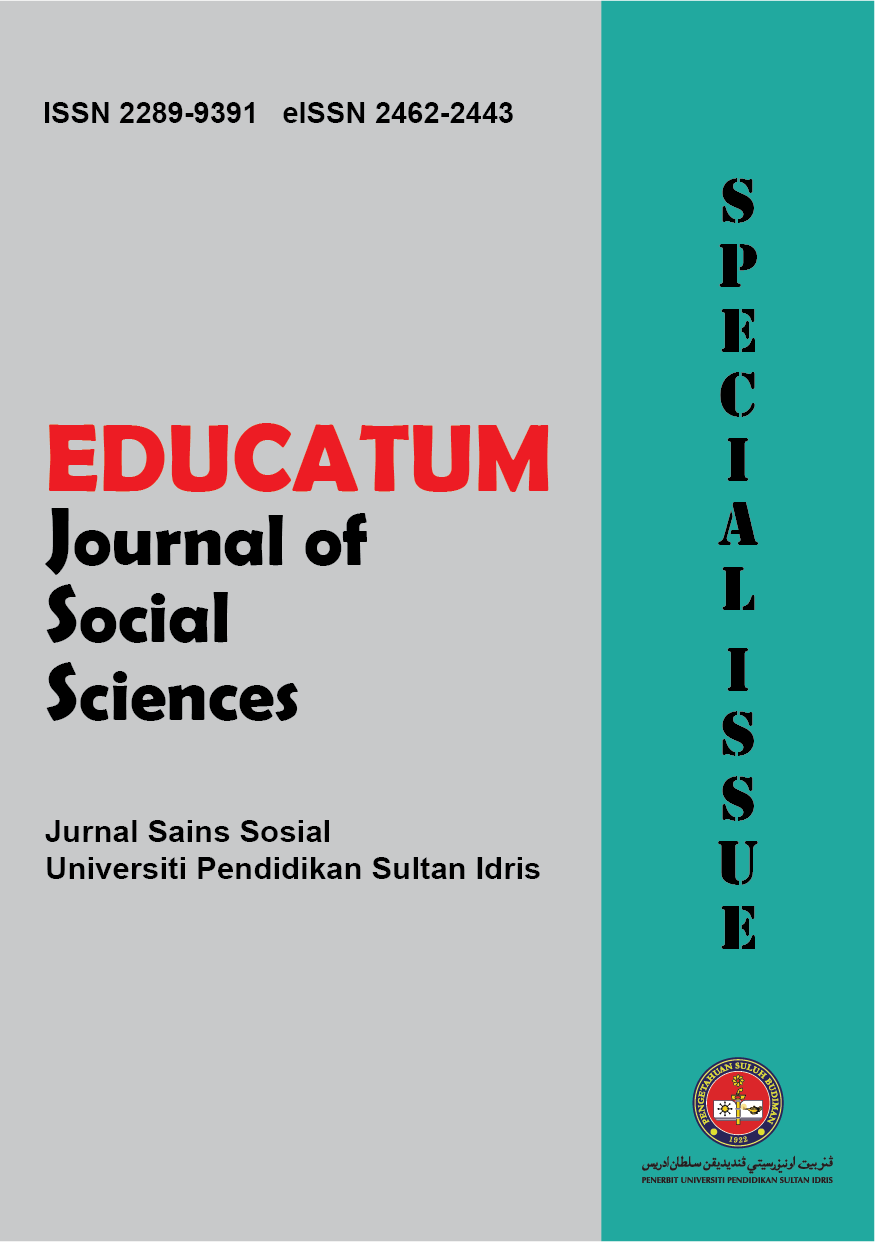The Exploration Novelty Seeking Factors Associated with Online Gaming Addiction among Adolescents in Malaysia
DOI:
https://doi.org/10.37134/ejoss.vol11.sp.1.2025Keywords:
Online gaming addiction, novelty seeking factors, adolescentsAbstract
Online gaming has become a common activity among adolescents in Malaysia. Hence, this study explored the novelty-seeking factors associated with online gaming addiction among adolescents in Malaysia. This study involved qualitative research in which 12 adolescents that were recruited through purposive sampling. Data were collected through interviews using several semi-structured questions after adolescents underwent a screening process using the Brief Sensation Seeking Scale (BSSS-8) and Internet Gaming Disorder (IGDSF-9). The interview transcript was analyzed using the thematic analysis method. The novelty-seeking factors that influence adolescents to become addicted to play online games have indicated three themes with eleven sub-themes, which are (a) experience-seeking factors, including enjoyable features, peer influence, skill development, making new friends, stress relief, role models, and generating side income, (b) thrill and adventurous seeking factors, including reward systems and challenging game features, and (c) boredom factors, including boredom and fulfilling leisure time. This research study can be a guideline to identify the factors that can influence adolescents to play Internet games and provide insight for early treatment that can be taken to prevent adolescents from becoming seriously addicted to games. Besides, this study also provides a depth understanding from the informant's perspective about the three significant novelty-seeking factors that may be associated with their gaming behavior.
Downloads
References
Achab, S., Rothen, S., Giustiniani, J., Nicolier, M., Franc, E., Zullino, D., Mauny, F. & Haffen, E. (2022). Predictors of Gaming Disorder or Protective from It, in a French Sample: A Symptomatic Approach to Self-Regulation and Pursued Rewards, Providing Insights for Clinical Practice. International Journal of Environmental Research and Public Health, 19 (15), 9476. doi: 10.3390/ijerph19159476
American Psychiatric Association [APA]. (2013). DSM-5: Diagnostic and statistical manual of mental disorders (5th ed.). Washington, DC: American Psychiatric Association.
Ankara, H. G., & Baykal, D. (2022). The socioeconomic and sociodemographic factors affecting digital gaming addiction among Generation Z. Telematics and Informatics Reports, 8, 100032. doi: 10.1016/j.teler.2022.100032
Arbeau, K., Thorpe, C., Stinson, M., Budlong, B., & Wolff, J. (2020). The meaning of the experience of being an online video game player. Computers in Human Behavior Reports, 2, 100013. doi: 10.1016/j.chbr.2020.100013
Balakrishnan, D., & George, S. (2020). Exploring the impact of internet gaming disorder on adolescent gamers using thematic analysis. PalArch's Journal of Archaeology of Egypt/Egyptology, 17(9), 6123-6130. doi: 10.17762/pae.v58i2.2972
Bekir, S., & Çelik, E. (2019). Examining the factors contributing to adolescents’ online game addiction. Anales De Psicología/Annals of Psychology, 35(3), 444-452. doi: 10.6018/analesps.35.3.323681
Braun, V., & Clarke, V. (2006). Using thematic analysis in psychology. Qualitative research in psychology, 3(2), 77-101. doi: 10.1191/1478088706QP063OA
Campbell, S., Greenwood, M., Prior, S., Shearer, T., Walkem, K., Young, S., Bywaters, D. & Walker, K. (2020). Purposive sampling: complex or simple? Research case examples. Journal of research in Nursing, 25(8), 652-661. doi: 10.1177/1744987120927206
Chatfield, S. L. (2020). Recommendations for secondary analysis of qualitative data. The Qualitative Report, 25(3), 833-842. doi: 10.46743/2160-3715/2020.4092
Hong, J., Wang, J., Qu, W., Chen, H., Song, J., Zhang, M., Zhao, Y., & Tan, S. (2022). Development and Internal Validation of a Model for Predicting Internet Gaming Disorder Risk in Adolescents and Children. Frontiers in Psychiatry, 13. doi: 10.3389/fpsyt.2022.873033
Jaafar, N. R. N., Baharudin, A., Tajjudin, I., Ling, L. S., Safarudin, M. A., Sufia, D. S., Tan, Y. H., Zulkifle, N. H., & Tan, K. A. (2021). Factors correlated with internet gaming disorder among Malaysian University students. Malaysian Journal of Medicine and Health Sciences 17(2), 54-62. doi: 10.13140/RG.2.2.26415.97444
Kiger, M. E., & Varpio, L. (2020). Thematic analysis of qualitative data: AMEE Guide No. 131. Medical teacher, 42(8), 846-854. doi: 10.1080/0142159X.2020.1755030
Larche, C. J., & Dixon, M. J. (2020). The relationship between the skill-challenge balance, game expertise, flow and the urge to keep playing complex mobile games. Journal of behavioral addictions, 9(3), 606-616. doi: 10.1556/2006.2020.00070
Liao, Z., Huang, Q., Huang, S., Tan, L., Shao, T., Fang, T., & Shen, H. (2020). Prevalence of internet gaming disorder and its association with personality traits and gaming characteristics among Chinese adolescent gamers. Frontiers in Psychiatry, 11, 598585. doi: 10.3389/fpsyt.2020.598585
Ling, S. L., Nik Jaafar, N. R., Tan, K. A., Bahar, N., Baharudin, A., & Ahmad Tajjudin, A. I. (2021). Psychometric Properties of the Malay Version of the Internet Gaming Disorder Scale-Short Form (IGDS9-SF-M): Evidence from a Sample of Malaysian Undergraduates. International journal of environmental research and public health, 18(5), 2592. doi: 10.3390/ijerph18052592
Merino-Soto, C.; Salas-Blas, E.; Pérez-Amezcua, B.; García-Rivas, J.; Peña, O.I.G.; Toledano-Toledano, F. (2022) Brief Sensations Seeking Scale (BSSS): Validity Evidence in Mexican Adolescents. Int. J. Environ. Res. Public Health, 19, 7978. doi: 10.3390/ijerph19137978
Paulus, F. W., Ohmann, S., Von Gontard, A., & Popow, C. (2018). Internet gaming disorder in children and adolescents: a systematic review. Developmental Medicine & Child Neurology, 60(7), 645-659. doi: 10.1111/dmcn.13754
Qin, L., Cheng, L., Hu, M., Liu, Q., Tong, J., Hao, W., Luo, T. & Liao, Y. (2020). Clarification of the cut-off score for nine-item Internet Gaming Disorder Scale–Short Form (IGDS9-SF) in a Chinese context. Frontiers in Psychiatry, 11, 470. doi: 10.3389/fpsyt.2020.00470
Teng, V. N., Manaf, A. R. A., Hamzah, M. R., Yusoff, H. A. M., Hussin, H., Ismail, A., & Ahmad, Y. (2021, May). Factors contributing to online gaming addiction: A cross-sectional survey among university students. In AIP Conference Proceedings (Vol. 2339, No. 1, p. 020144). AIP Publishing LLC. doi: 10.1063/5.0044226
Torres-Rodríguez, A., Griffiths, M. D., Carbonell, X., & Oberst, U. (2018). Internet gaming disorder in adolescence: Psychological characteristics of a clinical sample. Journal of behavioral addictions, 7(3), 707-718. doi: 10.1556/2006.7.2018.75
Vasileiou, K., Barnett, J., Thorpe, S., & Young, T. (2018). Characterising and justifying sample size sufficiency in interview-based studies: systematic analysis of qualitative health research over a 15-year period. BMC medical research methodology, 18(1), doi: 10.1186/s12874-018-0594
Downloads
Published
Issue
Section
License
Copyright (c) 2025 Siti Nor Safrina Muhamad Nor Bakri, Nor Firdous Mohamed

This work is licensed under a Creative Commons Attribution-NonCommercial-ShareAlike 4.0 International License.





